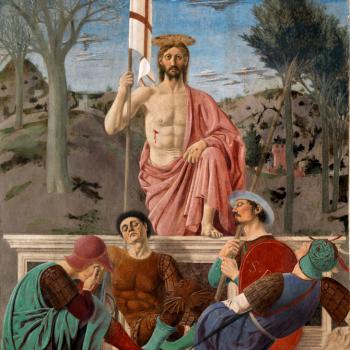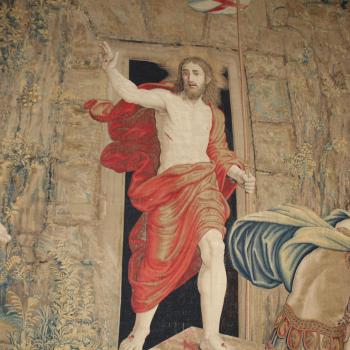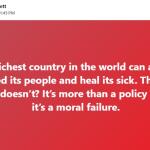Faithful Agnosticism
John 20:19-31
The gospels present four different pictures of the days following Jesus’ resurrection. While the original version of Mark ends with the empty tomb and frightened women, Matthew, Luke, and John provide a spiritual travelogue describing the fifty days between Jesus’ resurrection and ascension. It seems that the early church was content with different versions of the resurrection, based on different experiences and stories from Jesus’ first followers, and the needs and values of different communities and cultural contexts.
Resurrection is always more than we can fathom, but when it happens, everything changes; we come alive again. We can’t control it – it’s God’s work – but we can be open to it with great humility and a sense of our own limitations – intellectually, ethically, and spiritually. In the spirit of St. Augustine, we can accept the truth that “if you think you know it fully, it isn’t God” but something of your own creation. We cannot fully know what happened on Easter, but we can open to its life-changing reality and its promise of God’s ultimate victory over death and all that imprisons us and our companions on this good earth.
In today’s reading from John’s Gospel, the first reports of Christ’s resurrection have already been proclaimed. Mary of Magdala has seen the Risen One, and Peter and John have witnessed the empty tomb. But the community is still in shock, not sure what to believe or what will happen next.
What do you do with such amazing news? Could Jesus have really risen? They want to believe, but they are also concerned about having their hopes shattered once more.
Easter night, Jesus’ followers gather in the Upper Room, where a few days earlier they had shared Passover with Jesus. They are still fearful of what the authorities might do to them. Even resurrection can’t immunize us against arrest, persecution, sickness, aging, and death. In their anxiety, they gather simply to wait for what will happen next.
Then something amazing happens. Jesus appears out of nowhere, defying the known laws of nature. No doubt shocked at his presence, they need reassurance. Jesus gives it to them, “Peace be with you. My peace I give to you. In the midst of perplexity, fear, and uncertainty, you have my peace,” the Savior promises. Then he breathes on them and says, “receive the Holy Spirit.” And they are filled with hope; spiritually resuscitated, and ready to begin again.
Jesus gives them spiritual CPR. Once more they can take a full breath, and exhale. The breath of life restores their spirits and revives this small community. Now, Jesus will be as near to them as their next breath; now, every breath can be a prayer. Now, breathing itself can give God glory and the courage to step forward as they embrace their vocation as ambassadors of the Risen One.
How amazing that week must have been! Christ is alive! Death has been defeated!
Thomas missed Jesus’ return. We don’t know where he was: perhaps he went home, distraught, heartbroken, and hopeless. But he couldn’t stay away from his spiritual companions, and when he returned, he was greeted by a transformed community, filled with vitality and hope, and ready to move forward.
Thomas’ response to this amazing news is reasonable. “I won’t believe until I see for myself. Resurrections just don’t happen. I’m not about to abandon my intellect; I need facts before I trust the good news.” He doesn’t want to bet his life on a hoax or hallucination; he wants the real news of resurrection, not the false faith of hysteria.
Thomas is left out, but he hangs around. The only agnostic, the only doubter, the only outsider. Still, he stays. That in itself is a great act of faith.
There is something honest about Thomas’ response, and in many ways, his agnosticism is a model for us. There are a lot of faith peddlers out there in the religious world. There are lots of spiritual messages, trying to ensnare us with falsehoods and fake visions of God. They make amazing claims and wonderful promises; they say they can solve all your problems, cure all your ailments, and make you happy and rich, if you only trust them and, by the way, “we accept VISA, Mastercard, and American Express.”
Believe it or not, doubt is part of our faith journey, and is often a sign of how important something is to us. Questions are essential to a healthy faith. Faith demands sacrifice and allegiance, and we need to make sure we’ve put our faith in something worthy, something that can deliver what it promises when the going gets tough.
Jesus shows up, and Thomas is transformed. He goes out into the world, and according to legend travels as far as India to share the good news that Jesus is God’s Savior and gift to all humankind.
One of my favorite authors, Madeleine L’Engle, who penned A Wrinkle in Time, was once asked, “Do you believe in God without any doubts?” She responded, “I believe in God with all my doubts.”
We are resurrection people. But we proclaim resurrection in a world that challenges us every step of the way. We can’t understand why bad things happen to good people; we can’t understand why leaders intentionally put the planet at risk for the sake of profit; the brutality in Ukraine and across the globe overwhelms us as do the attacks on democracy and threats made on the lives of scientists and teachers in our own country; we struggle with the reality of poverty in a nation of plenty and the hate that infects so many hearts; and we don’t always understand ourselves. But, with all our struggles and doubts, we are challenged to trust in resurrection, and then practice resurrection, to do the unexpected, the impractical, and the impossible…to reach out with kindness and hope as justice seekers, peacemakers, and advocates for the persecuted and oppressed.
No one among Jesus’ first female and male followers expected resurrection; no one expected the spiritual CPR that would happen Easter night. But, in their uncertainty the disciples, the women and men, stuck around, waiting, hoping, for new life. And then, Thomas with all his doubts, embraced Christ when he appeared to him.
That’s our challenge, to wait for resurrection in our lives, the church, and the world. But waiting is not passive. As the prophet Isaiah says, “those wait on God will renew their strength, will rise up with the eagles, and run and not be weary, and walk and not tire.”
Here at church, we proclaim wonderful things about God’s grace and power to change our lives and the world. That’s the resurrection in action, and we can be people who, with all our struggles and doubts, launch out spiritually, trusting God’s presence and reaching out in love and care. We can practice resurrection today, as poet Wendell Berry says, by charting a new path, going against the grain of a death-filled and polarized society, sacrificing for the greater good whether in supporting Ukraine, welcoming immigrants, feeding the hungry, helping a friend, or embracing new life, where others see nothingness.
Yes, God is with us on the path, and with each new morning, we can proclaim, Christ the Lord is Risen Today. Hallelujah!
+++
Bruce Epperly is a professor, pastor, and spiritual guide, and author of over sixty books, including MYSTICS IN ACTION: TWELVE SAINTS FOR TODAY; PROPHETIC HEALING: HOWARD THURMAN’S VISION OF CONTEMPLATIVE ACTIVISM; PROCESS THEOLOGY AND POLITICS; TALKING POLITICS WITH JESUS: A PROCESS PERSPECTIVE ON THE SERMON ON THE MOUNT; and 101 SOUL SEEDS FOR PEACEMAKERS AND JUSTICE SEEKERS.












